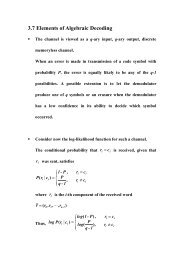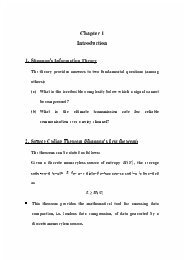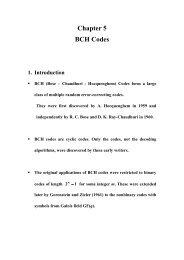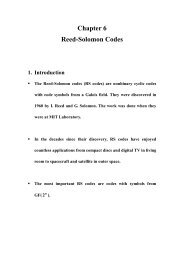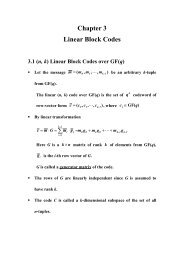9. Euclid’s Algorithm
You also want an ePaper? Increase the reach of your titles
YUMPU automatically turns print PDFs into web optimized ePapers that Google loves.
<strong>9.</strong> <strong>Euclid’s</strong> <strong>Algorithm</strong><br />
<br />
<strong>Euclid’s</strong> algorithm is a technique for finding the greatest common<br />
divisor ( a , b)<br />
of two integers or polynomials a and b .<br />
Proposition (2.18, page 48)<br />
Let a and b be two positive integers (or polynomials)<br />
Then if a = q1b<br />
+ r1<br />
for<br />
0 ≤ r1 < b ( 0 ≤ deg( r1 ) ≤ deg(<br />
b)<br />
)<br />
One has a , b)<br />
= ( b , r )<br />
(<br />
1<br />
where ( a , b)<br />
denotes greatest common divisor.<br />
b = q2r1<br />
+ r<br />
M<br />
rn-2<br />
= q r<br />
r = q<br />
n-1<br />
2<br />
+ r<br />
⇒<br />
( b , r ) = ( r<br />
n n-1 n<br />
n+ 1rn<br />
⇒ ( a , b)<br />
1<br />
= r<br />
n<br />
1<br />
, r )<br />
2<br />
Example:<br />
Suppose a = 186, b = 66 ,<br />
then<br />
186 = 66 ∗ 2<br />
66 = 54 ∗1<br />
54 = 12 ∗4<br />
12 = 6 ∗ 2<br />
+ 54<br />
+ 12<br />
+ 6<br />
+ 0<br />
the greatest common divisor is 6 .
<strong>Euclid’s</strong> Division <strong>Algorithm</strong> for Polynomials<br />
Given two polynomials a(x)<br />
and b(x)<br />
Their greatest common divisor can be computed by an iterative<br />
application of the division algorithm. If the degree of a(x)<br />
is<br />
greater than the degree of b (x)<br />
, the computation of GCD<br />
( a(<br />
x)<br />
, b(<br />
x)<br />
)<br />
is<br />
a(<br />
x)<br />
= q<br />
b(<br />
x)<br />
= q<br />
( x)<br />
( x)<br />
⋅ b(<br />
x)<br />
+ r<br />
r1 ( x)<br />
= q3<br />
( x)<br />
⋅ r2<br />
( x)<br />
+ r<br />
M<br />
r<br />
n-1<br />
( x)<br />
= q<br />
1<br />
2<br />
n+<br />
1<br />
( x)<br />
⋅ r<br />
⋅ r ( x)<br />
+ r<br />
1<br />
n<br />
( x)<br />
1<br />
2<br />
3<br />
( x)<br />
( x)<br />
( x)<br />
where the iterative process stops when a remainder of zero is<br />
obtained.<br />
Then the greatest common divisor of a(x)<br />
and b(x)<br />
is<br />
r n<br />
( x)<br />
= GCD( a(<br />
x)<br />
, b(<br />
x)<br />
)<br />
Example:<br />
a(<br />
x)<br />
=<br />
b(<br />
x)<br />
=<br />
x<br />
x<br />
3<br />
2<br />
+ 1<br />
+ 1<br />
x<br />
x<br />
3<br />
2<br />
2<br />
+ 1 = ( x + 1)<br />
⋅ x + ( x + 1)<br />
+ 1 = ( x + 1)<br />
⋅ x<br />
∴GCD of a ( x)<br />
and b(<br />
x)<br />
is x + 1
m<br />
10. Arithmetic Operations in GF( 2 )<br />
<br />
Primitive Elements<br />
m<br />
Consider the Galois field GF( 2 ) generated by the primitive<br />
polynomial<br />
p ( x)<br />
+<br />
2<br />
m-1 m<br />
= p0 + p1x<br />
+ p2<br />
x + L+<br />
pm−1x<br />
x<br />
Definition:<br />
The element α (a root of p (x)<br />
) whose powers<br />
m<br />
generate all the non-zero elements of GF( 2 )iscalleda<br />
m<br />
primitive element of GF( 2 ).<br />
In fact, any element β<br />
m<br />
in GF( 2 ) whose powers generate all<br />
m<br />
the nonzero elements of GF( 2 ) is a primitive element.<br />
Example:<br />
α<br />
4<br />
and<br />
7<br />
α<br />
4<br />
are also primitive elements of GF( 2 ).
Minimum Polynomial<br />
m<br />
(1) Consider the Galois field GF( 2 ) generated by a primitive<br />
polynomial p(x)<br />
of degree m. Let β be a non-zero<br />
m<br />
element of GF( 2 )<br />
Consider the powers<br />
β,<br />
β<br />
2<br />
,<br />
β<br />
2<br />
2<br />
,<br />
2<br />
L , β ,<br />
i<br />
L<br />
If e is the smallest nonnegative integer for which<br />
2<br />
β e<br />
= β<br />
Then the integer “ e ” is called the exponent of β .<br />
(2) consider the product,<br />
φ(<br />
x)<br />
= ( x + β )( x + β<br />
= a + a x + a x<br />
0<br />
1<br />
2<br />
e−1<br />
2<br />
2<br />
) L ( x + β )<br />
2<br />
e-1<br />
+ L+<br />
ae-1x<br />
+ x<br />
e<br />
is a polynomial of e degree.<br />
We can see that φ(x)<br />
is binary and irreducible over<br />
GF( 2 ). φ(x)<br />
is called the minimal polynomial of the<br />
element β .



